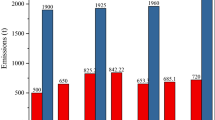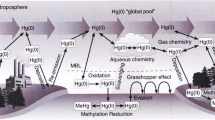Abstract
An estimate of the global emission of mercury from anthropogenicsources in 1995 has been prepared. Major emphasis is placed onemissions from stationary combustion sources, non-ferrous metalproduction, pig iron and steel production, cement production andwaste disposal. About three quarters of the total emission,estimated to be about 1900 tonnes, was from combustion of fuels, particularly coal combustion in China, India, and South and NorthKorea. In general, the Asian countries contribute about 56% to the global emissions of mercury to the atmosphere. Europe and North America seem to contribute less than 25%. The major chemical form of mercury emitted to the atmosphere is gaseouselemental mercury, contributing with about 53% to the totalemissions, followed by gaseous bivalent mercury with 37%. The Hg emissions on particles contribute only about 10% to the total emissions. Again, Asia contributes about 50% to the totalemissions of all individual chemical forms of mercury.
Similar content being viewed by others
References
AMAP: 1998, ‘AMAP Assessment Report: Arctic Pollution Issues’, Arctic Monitoring and Assessment Programme, Oslo, Norway.
Axenfeld, F., Münch, J. and Pacyna, J. M.: 1991, ‘Belastung von Nord-und Ostsee durch Ökologisch gefähriliche Stoffe am Beispiel atmosphĎDrischer Quecksilber-komponenten’, Dornier Report, Friedrichshafen, Germany, November.
CETEM: 1999, ‘Mercury as a Global Pollutant’ Proceedings of the 5th International Conference, Rio de Janeiro, Brazil, 23-28 May, 1999, Center for Mineral Technology, Rio de Janeiro, Brazil.
Jackson, T. A.: 1997, ‘Long-range atmospheric transport of mercury to ecosystems, and the importance of anthropogenic emissions - a critical review and evaluation of the published evidence’, Can. J. Environ. Rev. 2, 89–144.
MRI: 1993, ‘Locating and Estimating Air Emissions from Sources of Mercury and Mercury Compounds. Midwest Research Institute Report for the U.S. Environmental Protection Agency, (EPA-454/R-93-023). Research Triangle Park, NC.
Munthe, J.: 2000, ‘Mercury species over Europe: relative importance of depositional methylmercury fluxes to various ecosystems (MOE)’, in: ELOISE Implementation Report. Phase 2. European Commission (EC) Ecosystems Research Report 33, Brussels, Belgium.
Nriagu, J. O. and Pacyna, J. M.: 1988, ‘Quantitative assessment of worldwide contamination of air, water and soils by trace metals’, Nature 333, 134–139.
OECD: 1997, ‘Environmental Data Compendium 1995’, Organisation for Economic Co-operation and Development. Paris, France.
Pacyna, J. M.: 1996, ‘Emission Inventories of Atmospheric Mercury from Anthropogenic Sources’, in: W. Baeyens et al.(eds.), Global and Regional Mercury Cycles: Sources, Fluxes and Mass Balances, NATO ARW, D. Reidel Publishing Company, Dordrecht, the Netherlands.
Pacyna, J. M.: 1997, ‘Practical Opportunities and Technologies Available to Reduce Anthropogenic Emissions of Mercury to the Environment and to Reduce the Risks of Mercury Exposure to Humans and the Environment’, A report for the Commission for Environmental Cooperation (CEC) in North America, Montreal, Canada.
Pacyna, J. M. and Pacyna, E. P.: 1996, ‘Global emissions of mercury to the atmosphere. Emissions from anthropogenic sources’, A Report for the Arctic Monitoring and Assessment Programme (AMAP), Oslo, Norway, June.
Pacyna, E. G. and Pacyna, J. M.: 2000, ‘An assessment of global and regional emissions of trace metals to the atmosphere from anthropogenic sources worldwide’, Can. J. Environ. Rev., (submitted for publication).
Pirrone, N.: 2000, The Mediterranean atmospheric mercury cycle system (MAMCS), in: ELOISE Implementation Report. Phase 2. European Commission (EC) Ecosystems Research Report 33, Brussels, Belgium.
SFT: 2000, ‘Mercury Emission in Norway, 1995’, data from SFT and INKOSYS, Norwegian Pollution Control Authority, Oslo, Norway.
UN: 1997, ‘Statistical Yearbook’, United Nations, New York, NY.
UN: 1998, ‘Industrial Commodity Statistics Yearbook 1996’, United Nations, New York, NY.
UN ECE: 2000, ‘Joint EMEP/CORINAIR Atmospheric Emission Inventory Guidebook’, The United Nations Economic Commission for Europe, Geneva, Switzerland.
UNEP: 1996, ‘Environmental Data Report 1993-1994’, United Nations Environment Programme (UNEP). Nairobi, Kenya.
WBMS: 1999, ‘World Metal Statistics’, World Bureau of Metal Statistics. New York, NY, May.
Author information
Authors and Affiliations
Corresponding author
Rights and permissions
About this article
Cite this article
Pacyna, E.G., Pacyna, J.M. Global Emission of Mercury from Anthropogenic Sources in 1995. Water, Air, & Soil Pollution 137, 149–165 (2002). https://doi.org/10.1023/A:1015502430561
Issue Date:
DOI: https://doi.org/10.1023/A:1015502430561




